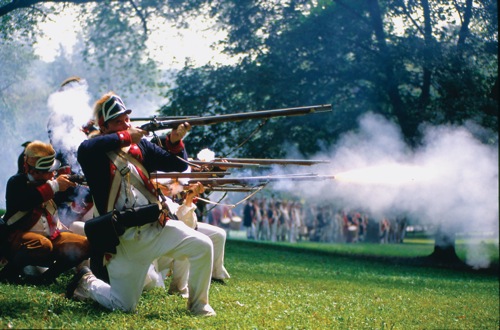
Courtesy Valley Forge CVB
Remnants of the Revolutionary War dot the Mid-Atlantic. From grassy battlefields to the homes of important figures of the time, these sites are a reminder of our country’s modest beginnings, the intense growing pains of the time and the bravery of our Founding Fathers.
Declaration (Graff) House
Philadelphia
When Thomas Jefferson was tasked with writing the Declaration of Independence, he sought solitude outside the hustle of Philadelphia in the red-brick Georgian home of Jacob Graff Jr. In three weeks, he crafted one of the most iconic documents of our country’s history.
The original house was torn down in 1883, but the National Park Service rebuilt it in 1975. Dubbed the Declaration House, or Graff House, the home is open year-round and offers a film on the drafting of the document and tours of the two second-floor rooms Jefferson occupied while writing it. The rooms are filled with period furniture and furnishings, among them reproductions of Jefferson’s swivel chair and lap desk.
— www.nps.gov/inde/declaration-house.htm —
Washington Crossing Historic Park
Washington Crossing, Pa.
The painting of George Washington crossing the Delaware River from Pennsylvania to New Jersey in a surprise attack on Trenton on Christmas night 1776 is a timeless image of the Revolutionary War and U.S. history. The subsequent battles and the “10 Crucial Days” were a turning point in the war and saved Washington’s army from ultimate defeat.
On the Pennsylvania side of the Delaware River is Washington Crossing Historic Park, which has numerous period buildings that put history in context. The visitors center features a documentary film and orientation to the area, and guided tours are available of the surrounding buildings, among them the Durham Boat House, which features replicas of boats similar to the ones used by Washington; the Thompson-Neely House; and Bowman’s Hill Tower.
— www.ushistory.org/washingtoncrossing —
Hale-Byrnes House
Stanton, Del.
Three days after a loss at Cooch’s Bridge, the only Revolutionary War battle fought in Delaware, Washington and his generals conferred at the Hale-Byrnes House for a council of war. Five days later, they fought the Battle of Brandywine.
The residence, built in 1750 by Samuel Hale, was sold to Daniel Byrnes four years later. Today it features period furniture and costumed interpreters who tell about the history of the home and its significance in the war.
The home is part of the Washington-Rochambeau National Historic Trail.









